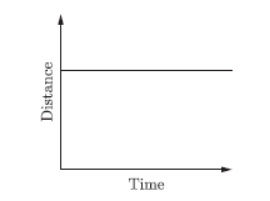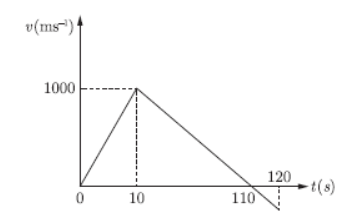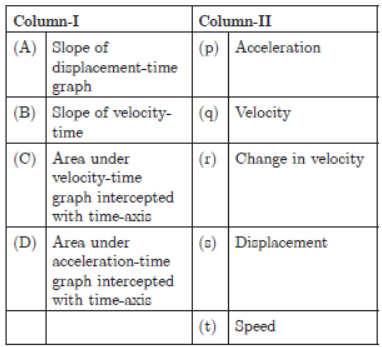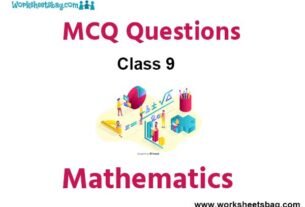Please refer to Motion MCQ Questions Class 9 Science below. These MCQ questions for Class 9 Science with answers have been designed as per the latest NCERT, CBSE books, and syllabus issued for the current academic year. These objective questions for Motion will help you to prepare for the exams and get more marks.
Motion MCQ Questions Class 9 Science
Please see solved MCQ Questions for Motion in Class 9 Science. All questions and answers have been prepared by expert faculty of standard 9 based on the latest examination guidelines.
MCQ Questions Class 9 Science Motion
OBJECTIVE QUESTIONS
Question. If a car at rest accelerates uniformly to a speed of 144 km/h in 20 sec., it covers a distance of
(a) 20 cm
(b) 400 m
(c) 1440 cm
(d) 2980 cm
Answer
B
Question. If a body moves with uniform velocity, then the acceleration is equal to
(a) zero
(b) constant
(c) finite
(d) infinite
Answer
A
Question. Which of the following speed time graphs is not possible ?

Answer
C
Question. The distance-time graph of an object is shown in graph. The object

(a) is at rest
(b) moves with a constant speed
(c) moves with a variable velocity
(d) moves with a constant acceleration
Answer
A
Question. If a car is traveling north on a straight road and its brakes are applied, it will
(a) have no acceleration
(b) accelerate to the south
(c) accelerate to the north
(d) accelerate either east or west
Answer
B
Question. The displacement x of a particle moving along a straight line at time t is given by
x = a0 + a1t + a2t2
What is the acceleration of the particle ?
(a) a1
(b) a2
(c) 2a2
(d) 3a2
Answer
C
Question. If a body is moving at constant speed in a circular path, its
(a) velocity is constant and its acceleration is zero
(b) velocity and acceleration are both changing direction only
(c) velocity and acceleration are both increasing
(d) velocity is constant and acceleration is changing direction
Answer
B
Question. The area under speed-6time graph represents a physical quantity whose unit is equal to the unit of
(a) light year
(b) area
(c) volume
(d) acceleration
Answer
A
Question. A passenger travels along the straight road for half the distance with velocity v1 and the remaining half distance with velocity v2. Then average velocity is given by
(a) v1v2
(b) v22 / v12
(c) (v1+v2) / 2
(d) v1v2 / (v1+v2)
Answer
D
Question. A particle covers half of the circle of radius r . Then the displacement and distance of the particle are respectively
(a) 2π r, 0
(b) 2r, π r
(c) π2/r , 2r
(d) πr, r
Answer
B
Question. The graph shows the variation of velocity of a rocket with time. Then, the maximum height attained by the rocket is

(a) 1.1 km
(b) 5 km
(c) 55 km
(d) none of these
Answer
C
Question. If the motion is in straight line without change in direction then
(a) distance ≠ |displacement|
(b) distance > |displacement|
(c) distance < |displacement|
(d) distance = |displacement|
Answer
D
FILL IN THE BLANK
Question. When negative acceleration acts on a moving body its velocity ……….
Answer
decreases
Question. If a car is going northward and the driver jams on its brakes, the direction of its acceleration is ……….
Answer
south
Question. Distance travelled divided by elapsed time gives ……….
Answer
average speed
Question. A stone is let to fall from a building of height 30m. The ratio of heights fallen by it after 2s and 3s is ……….
Answer
4 : 9
Question. A ball thrown vertically upwards return to its starting point in 4s. If g = 10 m/s2 , its initial speed was ……….
Answer
20 m/s
TRUE/FALSE
Question. Magnitude of acceleration is constant in the rotating motion along a circular path.
Answer
True
Question. Area under velocity-time graph shows displacement.
Answer
True
Question. If particle speed is constant, acceleration of the particle must be zero.
Answer
False
Question. Magnitude of displacement can be equal to or lesser than distance.
Answer
True
MATCHING QUESTIONS
Question.

Answer
(A) – (q), (B) – (p), (C) – (s), (D) – (r)
Question.

Answer
(A) – (s), (B) – (q), (C) – (t), (D) – (r), (E) – (p)
ASSERTION AND REASON
Question. Assertion : the speedometer of a car measures the instantaneous speed of the car.
Reason : Average speed is equal to the total distance covered by an object divided by the total time taken.
Options:
(a) Both assertion and reason are true and reason is the correct explanation of assertion.
(b) Both assertion and reason are true but reason is not the correct explanation of assertion.
(c) Assertion is true but reason is false.
(d) Both Assertion and Reason are false.
Answer
B
Question. Assertion : Displacement of an object may be zero even if the distance covered by it is not zero.
Reason : Displacement is the shortest distance between the initial and final position.
Options:
(a) Both assertion and reason are true and reason is the correct explanation of assertion.
(b) Both assertion and reason are true but reason is not the correct explanation of assertion.
(c) Assertion is true but reason is false.
(d) Both Assertion and Reason are false.
Answer
A
Question. Assertion : The displacement of an object can be either positive, negative or zero.
Reason : Displacement has both the magnitude and direction.
Options:
(a) Both assertion and reason are true and reason is the correct explanation of assertion.
(b) Both assertion and reason are true but reason is not the correct explanation of assertion.
(c) Assertion is true but reason is false.
(d) Both Assertion and Reason are false.
Answer
B
Question. Assertion : An object may have acceleration even if it is moving with uniform velocity.
Reason : An object may be moving with uniform velocity but it may be changing its direction of motion.
Options:
(a) Both assertion and reason are true and reason is the correct explanation of assertion.
(b) Both assertion and reason are true but reason is not the correct explanation of assertion.
(c) Assertion is true but reason is false.
(d) Both Assertion and Reason are false.
Answer
A
Question. Assertion : Velocity versus time graph of a particle in uniform motion along a straight path is a line parallel to the time axis.
Reason : In uniform motion the velocity of a particle increases as the square of the time elapsed.
Options:
(a) Both assertion and reason are true and reason is the correct explanation of assertion.
(b) Both assertion and reason are true but reason is not the correct explanation of assertion.
(c) Assertion is true but reason is false.
(d) Both Assertion and Reason are false.
Answer
C

